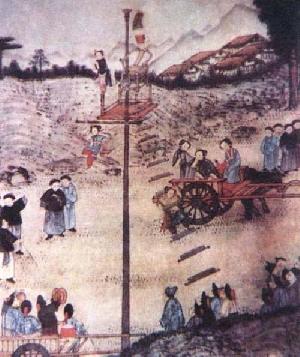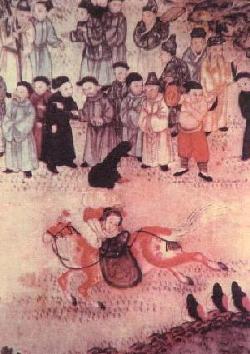|

|
| Pole Stunts and Climbing a Mountain of Swords, a Qing Dynasty genre painting |
Somersaulting, an important technique in acrobatics, was widely employed in Peking Opera during the Qing Dynasty one popular saying towards the end of the Qing period read: "Somersaulting to Peking Opera is like handstands to acrobatics." Anhui Opera was noted for its acrobatics prior to arriving in Beijing. Anhui Opera troupes never forgot to includeWuxiplays in their programs. Accounts by those who watched the performances note that Anhui Opera troupes incorporated many acrobatic stunts in their art.
Qing Dynasty acrobatic artists led miserable lives and were forced to roam from place to place in order to earn a living. However, their ardent love of the art passed on by their forebears enabled them to carry on and develop art traditions in spite of hardships. Juggling objects with the feet and the traditional form of conjuring known as ancient splendor were greatly improved during the Qing Dynasty, with the techniques of juggling jars, swords and balls reaching a much higher level. Many Qing genre paintings depict performances, with representative examples includingPole Stunts,Climbing a Mountain of SwordsandFeats on Horseback.
|

|
| Feats on Horseback, a Qing Dynasty genre painting |
Aside from acrobats who traveled from village to village, others highly skilled in their arts were often hired by wealth patrons to perform at parties held in their homes on festive occasions or at temple fairs when they offered incense to Buddha. Two reproductions of paintings in theDianshizhai Pictorialpublished towards the end of the Qing Dynasty depict an acrobatic performance on the street and flagpole juggling and stilt walking at a temple fair.
